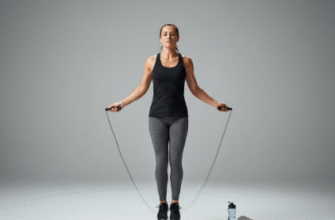Feeling pressed for time but still want to squeeze in some effective movement? Look no further than the nearest flight of stairs. Often overlooked, stair climbing is a surprisingly potent way to get your heart pumping and muscles working, all without needing fancy equipment or a gym membership. It’s readily available in most homes, apartment buildings, offices, and even public spaces. Think about it – you probably encounter stairs multiple times a day without even considering their workout potential.
The beauty of stair climbing lies in its simplicity and intensity. You’re working against gravity with every step up, engaging major muscle groups and significantly elevating your heart rate in a short amount of time. It’s a fantastic option for those days when a full hour at the gym just isn’t feasible, but you still crave that feeling of accomplishment and a good calorie burn. Forget the elevator guilt; start seeing those steps as your personal, vertical fitness track.
Why Choose Stairs for a Quick Burn?
What makes climbing stairs such a powerhouse workout? Firstly, it’s a fantastic cardiovascular exercise. Ascending stairs quickly elevates your heart rate, improving your aerobic fitness much like jogging or cycling, but often with a greater intensity due to the vertical challenge. You’ll likely find yourself breathing harder much faster than you would on a flat surface, which is a great sign your cardiovascular system is getting a solid workout.
Secondly, stair climbing is brilliant for strengthening lower body muscles. Each step up engages your glutes, quadriceps, hamstrings, and calves. It’s like doing lunges and squats with every single step, building functional strength that helps with everyday activities like walking, lifting, and maintaining balance. Unlike some repetitive exercises, the varying height and need for balance engage stabiliser muscles too.
Thirdly, it’s incredibly efficient. Because you’re lifting your entire body weight against gravity, you burn calories at a significantly faster rate compared to walking on level ground. Even a short, intense burst of stair climbing can contribute meaningfully to your daily energy expenditure. It’s a true high-intensity interval training (HIIT) option if you push the pace, allowing you to achieve significant results in minimal time. Plus, the impact is generally lower than running on hard surfaces, though proper form is still key.
Getting Started with Stair Climbing Workouts
Ready to give it a go? Starting is simple. The main thing you need is, well, a set of stairs! Most people have access to at least one flight, whether at home, work, or a nearby park or stadium.
Finding Your Stairs
Your home staircase is the most obvious and convenient starting point. Even a single flight of 10-15 steps can be used effectively by doing multiple repetitions. Apartment buildings often have longer stairwells perfect for sustained climbing. Office buildings can be great too, offering a chance for a midday energy boost – just be mindful of others using the stairs! Public parks sometimes have steps integrated into landscaping, or you might find bleachers at a local sports field or school (check for public access times). Choose a location where you feel comfortable and safe, and ideally one with good ventilation.
Warming Up and Cooling Down
Don’t just jump straight into intense climbing. Like any workout, a proper warm-up is essential. Start with 3-5 minutes of light activity to get your blood flowing and prepare your muscles. Think marching in place, leg swings (forward/back and side-to-side), ankle circles, and maybe a slow walk up and down the first few steps. After your stair session, cool down with 3-5 minutes of slower walking on level ground, followed by some gentle stretching, focusing on your calves, hamstrings, quads, and glutes. This helps your heart rate return to normal gradually and can aid in muscle recovery.
Focusing on Form
Good form makes your workout safer and more effective. Keep your posture upright – avoid hunching over the railing (use it lightly for balance if needed, but don’t rely on it to pull yourself up). Engage your core muscles to support your back. Place your entire foot on each step when ascending to maximize muscle engagement, particularly in the glutes. When descending, step lightly to minimize impact on your knees – walking down is usually recommended over running down, especially when starting out. Listen to your body; if you feel sharp pain, stop. Taking the time to ensure proper technique will pay off in the long run, making your climbs more productive and reducing the chance of strains or discomfort.
Stair Climbing Workout Variations
You don’t have to just trudge up and down monotonously. Mix things up to keep it interesting and challenge your body in different ways. Variety not only prevents boredom but also ensures you’re working your muscles from slightly different angles and intensities.
Steady State Climb
This is great for building endurance. Find a pace you can maintain consistently and climb continuously for a set duration, say 10-20 minutes. Walk back down slowly for recovery between ascents if needed (especially if using a shorter flight). Focus on rhythmic breathing and maintaining good form throughout. This method helps build your aerobic base and gets you comfortable with the movement before tackling more intense variations.
Interval Training (HIIT)
This is perfect for maximising calorie burn in minimal time. Alternate between periods of high-intensity climbing and recovery. For example:
- Climb as fast as you safely can for 30-60 seconds.
- Walk slowly back down or rest at the bottom/top for 60-90 seconds.
- Repeat this cycle for 8-15 rounds.
Adjust the work/rest times based on your fitness level. The goal is to push hard during the work intervals so the rest feels necessary. HIIT on stairs is particularly effective because the incline naturally increases the intensity, making even short bursts very challenging and beneficial for cardiovascular fitness.
Power Climbs
Focus on strength and power. Try taking two steps at a time (if the step height allows and you feel stable). This places more demand on your glutes and quads, acting almost like a plyometric exercise. Do this for shorter bursts or incorporate it into interval training. Ensure you have good balance and coordination before attempting this variation, and always prioritize safety over speed or step size. Landing firmly with your whole foot is key here too.
Adding Bodyweight Exercises
Turn your stairwell into a full-body circuit. Try climbing a flight, then doing a set of push-ups (using a step for incline if needed to adjust difficulty), squats, or tricep dips (using a bottom step, facing away) at the top or bottom before your next climb. This adds variety and works different muscle groups, turning your stair session into a more comprehensive workout without needing any extra equipment. Plan your circuit beforehand for a smooth flow.
Making Stairs a Habit
The key to seeing results from any form of exercise is consistency. Aim to incorporate stair climbing into your routine a few times per week. Even 10-15 minutes of focused stair work can make a difference over time. Start gradually, perhaps with shorter sessions or fewer repetitions, and progressively increase the duration, intensity, or frequency as you get fitter. Listen to your body and allow for rest days – recovery is just as important as the workout itself for muscle repair and preventing burnout. Remember, the best workout is one you can stick with. Finding ways to make it enjoyable, like listening to upbeat music (using one earbud if in a public stairwell for safety) or timing yourself to beat personal bests, can help maintain motivation.
Don’t underestimate the power of integrating stair climbing into your daily life either. Consciously choose the stairs over the elevator or escalator whenever possible. Heading to the third floor? Take the stairs. Need something from another level in your house? Walk up instead of shouting. These small bursts of activity accumulate throughout the day and contribute significantly to your overall fitness and well-being without carving out dedicated workout time. It’s a simple switch that requires no extra time, just a different choice that adds up significantly over weeks and months.
Check This: Proper form is crucial for both effectiveness and injury prevention when stair climbing. Always keep your back straight, core engaged, and place your whole foot on the step. Use railings for balance only, not to pull yourself up. Listen intently to your body’s signals and stop if you feel any sharp pain. Consistency, combined with good technique, is your best strategy for long-term results.
Stair climbing offers a convenient, effective, and challenging workout that requires minimal time and no special equipment. It targets major muscle groups, boosts cardiovascular health, and torches calories efficiently. It adapts to nearly any fitness level, from beginner walkers to advanced athletes looking for high-intensity drills. So next time you face a flight of stairs, see it not as an obstacle, but as an opportunity for a quick, powerful workout burn. Give it a try – you might be surprised at how quickly you feel the results and how easily it fits into even the busiest schedule!








